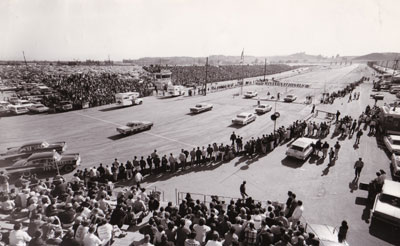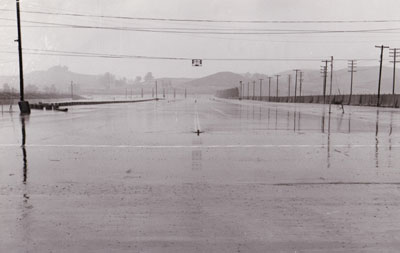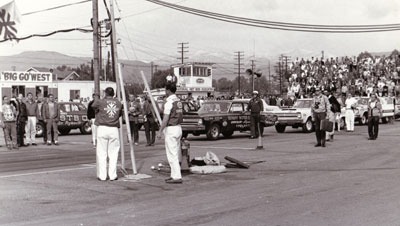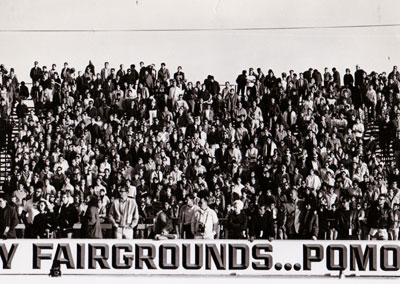

The one-day wonder
|
|
|
|
|
|
|
|
The Winternationals is always ripe with drama, whether it's because of new teams, new technology, or new plotlines, and few people walk away from the annual season opener disappointed. The race is that good.
Sometimes, though, fans can walk away shaking their heads in disbelief for more than just the accomplishment of the racers, and never was that more true than at the 1965 event. I mentioned in my column last week that the win by Roland Leong and driver Don Prudhomme at the 1965 race was especially memorable for more than just the fact that it marked "the Snake's" first win and kicked off an amazing two years for the Hawaiian dragster. Anyone who attended that race surely also will remember it as one of the most Herculean efforts ever expended by NHRA to complete an event.
Originally scheduled for three days, the event was reduced to just a single day by heavy fog and persistent rain Friday and Saturday. Some runs had been made between raindrops Friday, with Prudhomme's 7.80, 204.54 leading the way, just ahead of "Big Daddy" Don Garlits' 1964 Nationals-winning Wynn's Jammer, which chalked up a 7.81 at a blistering event-record 206.88 mph. But, save for a few Street-class runs, Saturday was a complete washout.
As NHRA officials glowered at the cloudy skies Saturday afternoon, they wondered if somehow they not only could allow all 612 participants to get their fair shot at Pomona glory in the seven traditional eliminators Sunday but also complete the hotly contested class runoffs – 70 classes in all – on the same day. Early estimates of the total number of runs needed to finish the race were in excess of 3,000. Can you imagine? It seemed to be a ludicrous proposition.
They ultimately envisioned – then flawlessly executed – a bold plan that will long be remembered and probably never repeated.
To alleviate expected traffic jams for an anticipated crowd of more than 60,000 fans eager to witness what would probably be the most action-packed single day of racing in history, ticket sales began at 10 p.m. Saturday, and the spectator gates were opened at midnight. Fans who had parked on the side streets adjacent to the L.A. County Fairgrounds streamed in, and by 4 a.m., most of the prime spots in the bleachers had been grabbed. Yet eager fans, primed by the Friday headlines, continued to roll in as the sun rose to reveal a standing-room-only crowd.
Event director Jack Hart lit the first engines at 7 a.m., and Chief Starter Buster Couch got 'em busy on Parker Avenue. Save for a one-minute, 45-second break as Couch and Pomona Valley Timing Association honcho John Moxley ran the Stars and Stripes up the flagpole and the national anthem played and a short downtime when an errant fueler took out the top-end lights, the Pomona quarter-mile was in use for the next 10 hours.
Among the class winners were names that would resound for years in the sport, with the likes of Cecil Yother, Dave Kempton, Bill Hoefer, Dave St
Writer Al Caldwell noted that pairs of Top Gas dragsters were leaving the line every 67 seconds and the fuelers at a rate of two every 72 seconds. The Top Gas field was set by 11 a.m. and the fuel field by noon, and eliminations began in earnest.
By the count of National DRAGSTER Associate Editor Dan Roulston, an average of 5.2 cars went down the track each minute of the 10 hours, and the combined mileage traveled by the entries down the track was about 790 miles under full power (DRAGSTER reporters jokingly called the event the "Pomona 800"). Adding in shutdown area and travel up the return road, Roulston estimated that the combined distance traveled would have carried someone east from
The Jr. Stock Eliminator final, which Kempton won, was the final pair down the track at just after 5 p.m. and 3,167 previous pairings. The racers and NHRA crew were so efficient that a half-hour of daylight still remained.
The Winternationals didn’t finish until well after that as NHRA's Farmer Dismuke and his tech crew worked well into Sunday night in teardown for the 28 cars that had their innards inspected, detected, and, in two cases, rejected.
"Drag racing is a highly emotional sport, and the heat of competition builds to a fever pitch," wrote Roulston, "but the cooperation extended to officials of the National Hot Rod Association by the racers at the 1965 Winternationals will probably never again be duplicated." Amen.

Speaking of Leong, Steve Justice was there when the Hawaiian made his first (and only) fuel-dragster pass behind the wheel, which led to Prudhomme taking over the reins. He remembers it well.
"Roland first showed off his new Fuller car Oct. 4, 1964," he wrote. "I worked the [eighth-mile] concession stand and witnessed Roland's initial pass in the car. C.J. [Hart, strip operator] had told him to make a half pass in the car and/or keep it under 150 mph. I just think things happened faster than he was used to, and by the time he passed me, the car was still hauling ass. He was in the left lane, and at about 1,000 feet, the car got into the dirt, kissed the fence, and went airborne.
"One could not really see anything after that, but word got back that Roland had come down right side up near the railroad tracks (quite a distance to the east of the strip). Roland was okay, but C.J. was livid and told Roland he would never drive a car at Lions while he was in charge. I also recollect that this incident was the reason C.J. initiated his driver's licensing program. Leong-Black was rebuilt and returned to the strip in January 1965 as the Hawaiian with Don Prudhomme at the wheel. It just took them a week or so to set a new speed record at Lions of 204 mph (hard to do on a Saturday night when the track was cold and dewy)."
I also got a lot of other comments from people who had never seen any color photos of the Hawaiian dragster and were surprised at what a pretty car it was. That's the downside to doing all of these historical articles; there aren’t always a lot of color photos. Most of the guys who were shooting for the weeklies shot black and white film for two reasons: 1) It was cheaper because they could process the film themselves, and 2) The publications themselves had not really advanced to color photography due to its cost.
Today, although we have to manage the use of color in National DRAGSTER to create an effecient press run, its use is much more widespread, and, of course, on the Internet, color is free. Can you imagine how cool it would have been to have had the Internet in 1965? Where would drag racing be today?
Okay, that's it for the week. In a few days, it's going to be Winternationals Week and the launch of a shiny new season. I can hardly wait.























































